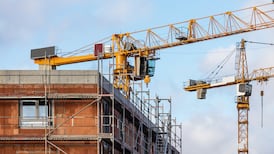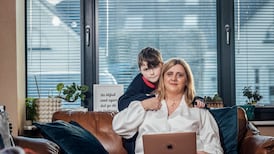Sporting a suit-and-sneakers combo and open-necked shirt, Jim Joyce looked more like he was back courting venture capitalists than the stock market establishment when he turned up at his medical technology company’s debut annual general meeting (agm) as a listed company earlier this month.
The business, HealthBeacon, might have set a record for the shortest agm in the Irish market in the process, lasting less than five minutes in a Dublin hotel. Even non-executive director Mary Harney, the former minister for health, quipped at the speed and lack of questions from a handful of investors in the room.
It may reflect the fact that the first physical agms season since the outbreak of Covid-19 has been a tentative one as much of the demographic that usually populates such meetings remains cautious about gatherings. Or it could be that investors are allowing Joyce a pass, for now, to get on with the job pitched to them when he came looking for €25 million in an initial public offering (IPO) late last year.
It’s a flotation that was lucky to get away last December before global equity markets cratered.
RM Block
“I think the timing, in retrospect, was a good decision,” says the 52-year-old Bostonian in a virtual interview this week from Orlando, Florida, where the company has an office in its fastest-growing market. “An earlier stage company [like HealthBeacon] wouldn’t otherwise have been able to pull an IPO off, and we would have had to look to the private markets for money and stay private for longer.”
Shares in HealthBeacon have fallen by as much as a third from their €5.85 IPO price (though they have staged a rally in recent days). Still, Joyce appears unfazed. “We are on such an early innings as a company, and people that are investing in us need to take a two-year perspective and enjoy the ride,” he says. “It’s an important company that has a global role to play. We have an excellent product and we have ambition around expanding out the product portfolio.”
The product he’s talking about is essentially a digital sharps bin that is a little bigger than a standard toaster. It is connected to an individual’s smartphone and used for the disposal of injector pens and syringes as well as to track individual patients’ adherence to medication regimes and to remind them to stay on track if necessary.
The problem with people not sticking to treatment plans is huge. According to the World Health Organisation, about half of patients fail to stay the course when long-term medication is prescribed. Some $177 billion of annual global healthcare expenditure and a quarter of all hospitalisations are down to non-adherence or poor adherence to medication schedules, according to estimates published by Research and Markets, a market research group, in 2020.
HealthBeacon research, peer reviewed and published in the International Journal of Clinical Pharmacy earlier this year, points to a 26 per cent improvement in therapy persistence by patients who administer injectable medications for a range of chronic, autoimmune conditions at home using the company’s solution.
The company estimates that the market of about 30 million people self-injecting with medicines across the US, Canada and Europe is worth about $10 billion a year.
Joyce also has ambitions to expand into digital solutions for management of pill-taking in the future as well as selling weighing scales connected to mobile devices, which would help medical care providers to track the effectiveness of medications in the treatment of ailments like obesity and diabetes.
But for now the company’s North Star, as he puts it, is to have 100,000 patients using its smart sharps bins by the end of next year – up from 10,187 last year.
Joyce, born to a large Irish-American family in Boston, graduated in 1992 from the Jesuit-led Fordham University in the Bronx in New York with an economics degree and followed his father into the world of investment broking. Following stints in Smith Barney (now part of Morgan Stanley) and AG Edwards, he moved to Dublin in 1995 to study for a masters of business administration (MBA) in the UCD Michael Smurfit Business Graduate School.
“As a third-generation Irish-American I had some familiarity with Ireland, and saw studying in the country as an opportunity. But there was also a practical reason: I was paying for the degree myself...and it was significantly less expensive to do it in Ireland.”
It was at Smurfit that he met his wife, Venetian Emanuela Saccarola, who was a visiting scholar at the time, and is now a senior executive with Citigroup in Dublin.
Joyce was recruited by US drugmaker Schering-Plough (now part of MSD) during a corporate hiring milk-round while at Smurfit. “I had an ambition at the time of getting into either one of two sectors: technology or the pharmaceutical industry,” he said.
After taking on various finance and planning roles with Schering-Plough in New Jersey, Joyce convinced his bosses in 2004 to allow him set up a subsidiary in Ireland.
As head of the Irish operation, responsible for the sale of tens of millions of euro of medicines for diseases like cancer, hepatitis and rheumatoid arthritis, Joyce saw a gap in the market to move treatments out of the hospital system. He left the group in late 2006 to set up Point of Care Health Services, a nursing business that administers intravenous infusions to patients with chronic conditions at, or close to, home.
Pharmacy group Uniphar, which was an early investor in the business, acquired the remainder of Point of Care in 2012 in a deal that allowed Joyce to take a project he was working on with him: HealthBeacon.
“It was a big idea and had its own risks as we had to learn how to build the technology and the product,” he says. “We realised it wouldn’t be successful unless it was [spun off] as an independent company that could go on and raise capital.”
Investors in various funding rounds before last year’s IPO included Enterprise Ireland, Bill McCabe’s Oyster Capital, Cantor Fitzgerald and Elkstone Partners.
While HealthBeacon launched its first product in Ireland in 2014, it is only in recent years that the company has had real sales momentum.
The company’s main distribution channel to date has been through deals with pharmaceutical companies, including Sanofi, Novartis and Teva, who cover the cost of the devices. It has also expanded recently into selling units directly to consumers in the US through home appliances distributor Hamilton Beach Brands, and is developing a sales channel where costs are reimbursed by health insurance programmes.
The Covid-19 pandemic presented its own opportunities and challenges.
“It accelerated the broad category of digital health adoption by years,” he said. “All of our patients would have autoimmune conditions, and would have been very vulnerable to Covid infections, more so than the average population. We saw our discussions with pharmaceutical companies and health systems accelerate because of their desire to do deals with us around that technology.”
However, during the worst of the pandemic hospitals scaled back on starting patients off on new therapies. Meanwhile, the uneven reopening of economies from lockdown has led to all sorts of supply chain issues and inflation across everything from plastics, computer chips and transport used by HealthBeacon.
“For example – and we never would have thought about this – Ireland essentially ran out cardboard at the end of last year,” he recalls. “So we had to look further afield to get packaging for our units.”
While Joyce had hoped to increase the company’s gross profit margin as the company grows at pace over the next 18 months from 60 per cent, currently, general inflation has put paid to that. “We’ve secured everything we need to deliver our target of getting to 100,000 devices by the end of next year. But we’ve had to plan carefully,” he said, adding that it will likely be next year before problems in global supply chains ease.
Of the dozens of Irish companies that have gone through a pre-IPO programme, called IPOready, that has been running at Euronext Dublin since 2015, HealthBeacon is the only one that has taken the plunge to date. It was also only one of two Dublin flotations last year at a time even as IPOs were running at a record rate globally.
But for Joyce it was a no-brainer. Firstly, he says that the ability of the company to generate recurring revenue is an obvious attraction for stock market investors. So too is its growth story, which will likely require additional capital investment in future.
“But the imprimatur of being a publicly traded company, and the transparency that comes with that, would also give further confidence to our customers and our clients to adopt our technology,” he said. “Indeed, the investment markets, I think, might act as a vehicle to evangelise our technology.”
Why haven’t more Irish companies taken the same route? The answer is complicated, according to Joyce. The ecosystem of investment firms, market service providers, and sovereign wealth funds with a focus on backing companies on track to go public doesn’t exist in Dublin to the extent as in other markets such as in Scandinavia or France.
While the Ireland Strategic Investment Fund (ISIF) has backed some companies, such as investment firm Draper Esprit (now Molten Ventures) and wind farm business Greencoat Renewables, that have floated in the past six years, Joyce said that the sovereign wealth fund should have an “active agenda to see, say, five companies a year go public”.
“Ireland should invest in trying to ensure companies go public and think about everything from tax incentives to liquidity for investors in the marketplace, so that you don’t have companies nearly always going down the trade sale route,” he said. “There are over 200 digital health companies in Ireland alone. There should be no reason why a handful of those shouldn’t take a serious look over the next few years at going public.”
Joyce will also be aware that HealthBeacon’s prospects of remaining on the market over the long term depend on him building a company of a sufficient size to attract a broad range of investors. With a market capitalisation of less than €75 million the company is off the radar of even many small-cap institutional investors that will not look at anything valued below €250 million-€300 million.
The company is expected by investors to seek to raise further equity as it continues to grow. It also said in its IPO documents that it will “actively consider” acquisitions and partnerships “to expand its offering to a greater number of patients and customers with a growing number of diseases and conditions”.
“A lot of the investors that we talked to (before the IPO) said, ‘We want to get to know you, but we only invest in companies valued over €250 million or €500 million’,” he said. “We’re on that path...And we’d have ambitions beyond that, frankly. This is a company that has the capacity to go well beyond that.”
CV:
Name: Jim Joyce
Title: CEO of HealthBeacon
Lives: Ranelagh, Dublin 6
Family: Married to Citigroup banker Emanuela Saccarola, with two sons
Something you might expect: Joyce and his five siblings have a tradition of taking their families for a large annual vacation to Martha’s Vineyard, the storied Massachusetts getaway island
Something about him that might surprise: He takes an e-bike to work in Bluebell, Dublin 12





















